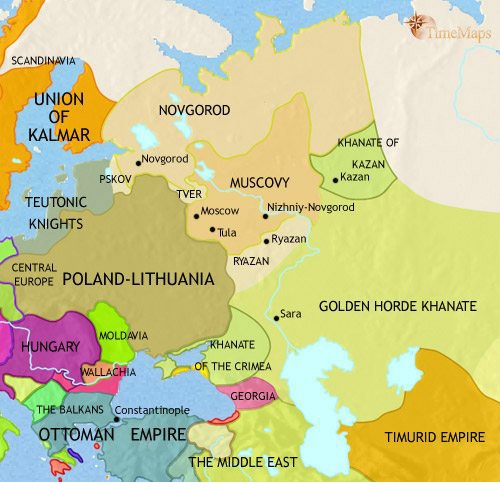POLAND AND LITHUANIA
In 1340, the last Prince of Galicia-Volhynia, Yurii II Boleslav, was murdered, poisoned by his boyars. Galicia fell into disarray and was fought over by different Galician factions, Hungary and Poland until, through an agreement between Poland, Hungary and Lithuania, it was incorporated into Poland in 1387. After struggles with Poland, Lithuania gained control of Volhynia in 1370. (5)
(5) I should explain that Galicia and Volhynia are flexible geographical entities. The present day 'Volyn' is an oblast in the extreme west of Ukraine but at one time it stretched through the neighbouring oblast of Rivne into Zhytomir, abutting the region of Kiev. 'Galicia' is now divided between a Ukrainian Galicia, centred on Lviv, and a Polish Galicia, centred on Cracow.
Lithuania had emerged as a power in the thirteenth century in conflict with the Teutonic Knights who had moved into the area on the Baltic now known as East Prussia. The Lithuanians at that time were still pagan but they were becoming Christian, using the Eastern rite, partly perhaps in reaction to the Teutonic Knights and partly through the influence of Volhynia. They had already, prior to 1340, taken some of the Volhynian lands and they had the support of the boyars who killed Yurii. They constituted, together with Poland, a bulwark against the Tatars. They also took more eastward areas of the old Kievan Rus'. According to Pospielovsky (p.81): 'In general, Kiev's fate in the period between the Mongol conquest in 1241 and its annexation by the Lithuanian prince Vitoft in the early fifteenth century remains unclear.' But the Encyclopedia of Ukraine entry on Kyiv has it annexed to Lithuania from 1362 through to 1482, when it was again sacked by the Tatars.
In 1386, more or less coinciding with the incorporation of Galicia into Poland, the Lithuanian Grand Duke Iagello married the Polish Queen Hedwig, converted to Catholicism and became King of Poland as King Wladyslaw II. Catholicism became the only legal religion of the Grand Duchy. The result was a war with his cousin Vitautas (Pospielovsky's 'Vitoft'), finally resulting in the Union of Horodlo in 1413, which kept the Grand Duchy of Lithuania in existence as a distinct moral entity, albeit subject to the Polish King, and allowed the continuation of the Orthodox Church. To quote the Encyclopedia's entry on the Union of Horodlo: 'Under the terms of the agreement the Catholic nobles of Lithuania were granted equality with their Polish counterparts; Orthodox (mostly Ruthenian) nobles, however, were consigned to second class status and prohibited from full participation in state affairs.'

Poland-Lithuania and Muscovy in 1453, soon after the fall of Constantinople
The Encyclopedia says of the term 'Ruthenian', used here: 'The name Rutheni came to be applied to the inhabitants of Kyivan Rus' as a result of the medieval practice of giving newly encountered peoples the names of extinct ancient peoples. Boris Unbegaun has suggested that the attested Latin Rucenus, a rendering of the Old Ukrainian rusyn, was instrumental in the selection of the name Ruthenus. The first use of the word Ruteni in reference to the inhabitants of Rus' was in the Annales Augustiani of 1089. For centuries thereafter Rutheni was used in Latin as the designation of all East Savs, particularly Ukrainians and Belarusians. In the 16th century the word more clearly began to be associated with the Ukrainians and Belorusians of the Polish-Lithuanian Commonwealth as distinct from the Muscovites (later known as Russians), who were designated Moscovitae.' (6) I shall use the term 'Ruthenian' to refer to the Eastern Slav subjects of Poland until it seems to me, some time in the seventeenth century, that the term 'Ukrainian' begins to be appropriate.
(6) This particular entry in the Encyclopedia is written by the Ukrainian-Canadian historian, John-Paul Himka, a particularly interesting writer on Ukrainian nationalism, who will feature prominently in the next part of this article. In his essay 'Young radicals and independent statehood: the idea of a Ukrainian nation-state, 1890-1895', Slavic Review, Summer 1982, Vol 41, No 2, Himka says: 'At least until the turn of the century, the Eastern-rite, Ukrainian-speaking inhabitants of Austria-Hungary referred to themselves as "Ruthenians" (rusyny) and to their conationals across the Russian border as "Ukrainians" (ukraintsi). As of 1900, nationally conscious Ukrainians in Galicia shunned this distinction and began referring to themselves, too, as "Ukrainians." The formulation of the goal of national statehood contributed to the terminological reorientation.'
In parenthesis it may be noted that 1380, coincidental with the Polish-Lithuanian capture of Galicia-Volhynia, was the year of the Battle of Kulikovo, the victory of the Muscovite Prince Dmitri Donskoi, traditionally seen as the moment of the liberation of Muscovy from the Tatar Yoke. More or less at the same time, Bulgaria and most of Serbia fell to the Ottomans.